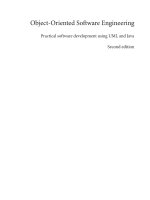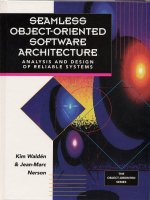Component-based software engineering
Bạn đang xem bản rút gọn của tài liệu. Xem và tải ngay bản đầy đủ của tài liệu tại đây (101.41 KB, 16 trang )
Component-based software
engineering
©Ian Sommerville 2004
Software Engineering, 7th edition. Chapter 19
Slide 1
Objectives
To explain that CBSE is concerned with
developing standardised components and
composing these into applications
To describe components and component
models
To show the principal activities in the CBSE
process
To discuss approaches to component
composition and problems that may arise
©Ian Sommerville 2004
Software Engineering, 7th edition. Chapter 19
Slide 2
Topics covered
Components and component models
The CBSE process
Component composition
©Ian Sommerville 2004
Software Engineering, 7th edition. Chapter 19
Slide 3
1
Component-based development
Component-based software engineering
(CBSE) is an approach to software
development that relies on software reuse.
It emerged from the failure of object-oriented
development to support effective reuse.
Single object classes are too detailed and
specific.
Components are more abstract than object
classes and can be considered to be standalone service providers.
©Ian Sommerville 2004
Software Engineering, 7th edition. Chapter 19
Slide 4
CBSE essentials
Independent components specified by their
interfaces.
Component standards to facilitate
component integration.
Middleware that provides support for
component inter-operability.
A development process that is geared to
reuse.
©Ian Sommerville 2004
Software Engineering, 7th edition. Chapter 19
Slide 5
CBSE and design principles
Apart from the benefits of reuse, CBSE is
based on sound software engineering design
principles:
•
•
•
•
Components are independent so do not
interfere with each other;
Component implementations are hidden;
Communication is through well-defined
interfaces;
Component platforms are shared and reduce
development costs.
©Ian Sommerville 2004
Software Engineering, 7th edition. Chapter 19
Slide 6
2
CBSE problems
Component trustworthiness - how can a component
with no available source code be trusted?
Component certification - who will certify the quality
of components?
Emergent property prediction - how can the
emergent properties of component compositions be
predicted?
Requirements trade-offs - how do we do trade-off
analysis between the features of one component
and another?
©Ian Sommerville 2004
Software Engineering, 7th edition. Chapter 19
Slide 7
Components
Components provide a service without
regard to where the component is executing
or its programming language
•
•
A component is an independent executable
entity that can be made up of one or more
executable objects;
The component interface is published and all
interactions are through the published interface;
©Ian Sommerville 2004
Software Engineering, 7th edition. Chapter 19
Slide 8
Component definitions
Councill and Heinmann:
•
A software component is a software element that
conforms to a component model and can be
independently deployed and composed without
modification according to a composition standard.
Szyperski:
•
A software component is a unit of composition with
contractually specified interfaces and explicit context
dependencies only. A software component can be
deployed independently and is subject to composition by
third-parties.
©Ian Sommerville 2004
Software Engineering, 7th edition. Chapter 19
Slide 9
3
Component as a service provider
The component is an independent,
executable entity. It does not have to be
compiled before it is used with other
components.
The services offered by a component are
made available through an interface and all
component interactions take place through
that interface.
©Ian Sommerville 2004
Software Engineering, 7th edition. Chapter 19
Slide 10
Component characteristics 1
Standardised
Component standardisation means that a component that is
used in a CBSE process has to conform to some standardised
component model. This model may define component
interfaces, component meta-data, documentation, composition
and deployment.
Independen t
A component should be independen t Š it should be possible to
compose and deploy it without having to use other specific
components. In situations where the component needs
externally p rovided services, these should be explicitly set out
in a Ō
requiresÕinterface specification.
Composable
For a component to be composable, all external interactions
must take place through publicly defined interfaces. In
addition, it must provide external access to information about
itself such as its methods and attributes.
©Ian Sommerville 2004
Software Engineering, 7th edition. Chapter 19
Slide 11
Component characteristics 2
Deployab le
To be deployab le, a component has to be se lf-contained and
must be able to operate as a stand-alone entity on some
component platform that implements the component model.
This usually means that the component is a binary co mponent
that does not have to be compiled before it is deployed .
Documented
Components have to be fully docu mented so that potential
users of the component can decide whether or not they meet
their needs. The syntax and , ideally, the semantics of all
component interfaces have to be specified.
©Ian Sommerville 2004
Software Engineering, 7th edition. Chapter 19
Slide 12
4
Component interfaces
Provides interface
•
Defines the services that are provided by the
component to other components.
Requires interface
•
Defines the services that specifies what
services must be made available for the
component to execute as specified.
©Ian Sommerville 2004
Software Engineering, 7th edition. Chapter 19
Slide 13
Component interfaces
Requires int er face
Provides int er face
Defines the services
fromthecomponent’s
environment that it
uses
©Ian Sommerville 2004
Component
Defines the services
that are provided
by the component
to other components
Software Engineering, 7th edition. Chapter 19
Slide 14
A data collector component
Requires int er face
Provides int er face
sensorManagement
Data collector
addSensor
removeSensor
star tSensor
stopSensor
testSensor
initialise
sensorData
repor t
listAll
©Ian Sommerville 2004
Software Engineering, 7th edition. Chapter 19
Slide 15
5
Components and objects
Components are deployable entities.
Components do not define types.
Component implementations are opaque.
Components are language-independent.
Components are standardised.
©Ian Sommerville 2004
Software Engineering, 7th edition. Chapter 19
Slide 16
Component models
A component model is a definition of standards for
component implementation, documentation and
deployment.
Examples of component models
•
•
•
EJB model (Enterprise Java Beans)
COM+ model (.NET model)
Corba Component Model
The component model specifies how interfaces
should be defined and the elements that should be
included in an interface definition.
©Ian Sommerville 2004
Software Engineering, 7th edition. Chapter 19
Slide 17
Elements of a component model
Customisation
Naming
convention
Composition
Inter face
definition
Specific
inter faces
Inter faces
Documentation
Meta-data
access
Usage
information
Packag ing
Evolution
suppor t
Deployment
and use
Component model
©Ian Sommerville 2004
Software Engineering, 7th edition. Chapter 19
Slide 18
6
Middleware support
Component models are the basis for middleware
that provides support for executing components.
Component model implementations provide:
•
•
Platform services that allow components written
according to the model to communicate;
Horizontal services that are application-independent
services used by different components.
To use services provided by a model, components
are deployed in a container. This is a set of
interfaces used to access the service
implementations.
©Ian Sommerville 2004
Software Engineering, 7th edition. Chapter 19
Slide 19
Component model services
Horizontal services
Component
management
Transaction
management
Concurrency
Persistence
Resource
management
Security
Platform services
Addressing
©Ian Sommerville 2004
Inter face
definition
Exception
management
Component
communications
Software Engineering, 7th edition. Chapter 19
Slide 20
Component development for reuse
Components developed for a specific
application usually have to be generalised to
make them reusable.
A component is most likely to be reusable if it
associated with a stable domain abstraction
(business object).
For example, in a hospital stable domain
abstractions are associated with the
fundamental purpose - nurses, patients,
treatments, etc.
©Ian Sommerville 2004
Software Engineering, 7th edition. Chapter 19
Slide 21
7
Component development for reuse
Components for reuse may be specially constructed by
generalising existing components.
Component reusability
• Should reflect stable domain abstractions;
• Should hide state representation;
• Should be as independent as possible;
• Should publish exceptions through the component
interface.
There is a trade-off between reusability and usability
• The more general the interface, the greater the reusability
but it is then more complex and hence less usable.
©Ian Sommerville 2004
Software Engineering, 7th edition. Chapter 19
Slide 22
Changes for reusability
Remove application-specific methods.
Change names to make them general.
Add methods to broaden coverage.
Make exception handling consistent.
Add a configuration interface for component
adaptation.
Integrate required components to reduce
dependencies.
©Ian Sommerville 2004
Software Engineering, 7th edition. Chapter 19
Slide 23
Legacy system components
Existing legacy systems that fulfil a useful
business function can be re-packaged as
components for reuse.
This involves writing a wrapper component
that implements provides and requires
interfaces then accesses the legacy system.
Although costly, this can be much less
expensive than rewriting the legacy system.
©Ian Sommerville 2004
Software Engineering, 7th edition. Chapter 19
Slide 24
8
Reusable components
The development cost of reusable
components may be higher than the cost of
specific equivalents. This extra reusability
enhancement cost should be an organization
rather than a project cost.
Generic components may be less
space-efficient and may have longer
execution times than their specific
equivalents.
©Ian Sommerville 2004
Software Engineering, 7th edition. Chapter 19
Slide 25
The CBSE process
When reusing components, it is essential to
make trade-offs between ideal requirements
and the services actually provided by
available components.
This involves:
•
•
•
Developing outline requirements;
Searching for components then modifying
requirements according to available
functionality.
Searching again to find if there are better
components that meet the revised
requirements.
©Ian Sommerville 2004
Software Engineering, 7th edition. Chapter 19
Slide 26
The CBSE process
Outline
system
requir ements
Identify candidate
components
Modify
requir ements
accor ding to discovered
components
Architectur al
design
Identify candidate
components
Compose
components to
create system
©Ian Sommerville 2004
Software Engineering, 7th edition. Chapter 19
Slide 27
9
The component identification process
Component
search
©Ian Sommerville 2004
Component
selection
Component
validation
Software Engineering, 7th edition. Chapter 19
Slide 28
Component identification issues
Trust. You need to be able to trust the supplier of a
component. At best, an untrusted component may
not operate as advertised; at worst, it can breach
your security.
Requirements. Different groups of components will
satisfy different requirements.
Validation.
•
•
The component specification may not be detailed enough
to allow comprehensive tests to be developed.
Components may have unwanted functionality. How can
you test this will not interfere with your application?
©Ian Sommerville 2004
Software Engineering, 7th edition. Chapter 19
Slide 29
Ariane launcher failure
In 1996, the 1st test flight of the Ariane 5 rocket
ended in disaster when the launcher went out of
control 37 seconds after take off.
The problem was due to a reused component from a
previous version of the launcher (the Inertial
Navigation System) that failed because assumptions
made when that component was developed did not
hold for Ariane 5.
The functionality that failed in this component was
not required in Ariane 5.
©Ian Sommerville 2004
Software Engineering, 7th edition. Chapter 19
Slide 30
10
Component composition
The process of assembling components to
create a system.
Composition involves integrating
components with each other and with the
component infrastructure.
Normally you have to write ‘glue code’ to
integrate components.
©Ian Sommerville 2004
Software Engineering, 7th edition. Chapter 19
Slide 31
Types of composition
Sequential composition where the composed
components are executed in sequence. This
involves composing the provides interfaces of each
component.
Hierarchical composition where one component calls
on the services of another. The provides interface of
one component is composed with the requires
interface of another.
Additive composition where the interfaces of two
components are put together to create a new
component.
©Ian Sommerville 2004
Software Engineering, 7th edition. Chapter 19
Slide 32
Types of composition
A
A
B
A
B
(a)
©Ian Sommerville 2004
B
(b)
(c)
Software Engineering, 7th edition. Chapter 19
Slide 33
11
Interface incompatibility
Parameter incompatibility where operations
have the same name but are of different
types.
Operation incompatibility where the names
of operations in the composed interfaces are
different.
Operation incompleteness where the
provides interface of one component is a
subset of the requires interface of another.
©Ian Sommerville 2004
Software Engineering, 7th edition. Chapter 19
Slide 34
Incompatible components
string location(string pn)
phoneDatabase (string command)
addressFinder
string owner (string pn)
string proper tyType (string pn)
displayMap (string postCode, scale)
mapDB (string command)
mapper
©Ian Sommerville 2004
printMap (string postCode, scale)
Software Engineering, 7th edition. Chapter 19
Slide 35
Adaptor components
Address the problem of component
incompatibility by reconciling the interfaces
of the components that are composed.
Different types of adaptor are required
depending on the type of composition.
An addressFinder and a mapper component
may be composed through an adaptor that
strips the postal code from an address and
passes this to the mapper component.
©Ian Sommerville 2004
Software Engineering, 7th edition. Chapter 19
Slide 36
12
Composition through an adaptor
The component postCodeStripper is the
adaptor that facilitates the sequential
composition of addressFinder and mapper
components.
address = addressFinder.location (phonenumber) ;
postCode = postCodeStripper.getPostCode (address) ;
mapper.displayMap(postCode, 10000)
©Ian Sommerville 2004
Software Engineering, 7th edition. Chapter 19
Slide 37
Adaptor for data collector
sensorManagement
addSensor
removeSensor
star tSensor
star t
sensor
stop
getdata
©Ian Sommerville 2004
Adapter
Data collector
sensorData
Software Engineering, 7th edition. Chapter 19
stopSensor
testSensor
initialise
repor t
listAll
Slide 38
Interface semantics
You have to rely on component
documentation to decide if interfaces that are
syntactically compatible are actually
compatible.
Consider an interface for a PhotoLibrary
component:
public void addItem (Identifier pid ; Photograph p; CatalogEntry photodesc) ;
public Photograph retrieve (Identifier pid) ;
public CatalogEntry catEntry (Identifier pid) ;
©Ian Sommerville 2004
Software Engineering, 7th edition. Chapter 19
Slide 39
13
Photo library composition
getImage
addItem
adaptor
Photo
Library
retrieve
catEntry
Image
Manager
getCatalogEntry
User
Inter face
©Ian Sommerville 2004
Software Engineering, 7th edition. Chapter 19
Slide 40
Photo Library documentation
“This method adds a photograph to the library and
associates the photograph identifier and catalogue
descriptor with the photograph.”
“what happens if the photograph identifier is already
associated with a photograph in the library?”
“is the photograph descriptor associated with the
catalogue entry as well as the photograph i.e. if I delete
the photograph, do I also delete the catalogue
information?”
©Ian Sommerville 2004
Software Engineering, 7th edition. Chapter 19
Slide 41
The Object Constraint Language
The Object Constraint Language (OCL) has
been designed to define constraints that are
associated with UML models.
It is based around the notion of pre and post
condition specification - similar to the
approach used in Z as described in Chapter
10.
©Ian Sommerville 2004
Software Engineering, 7th edition. Chapter 19
Slide 42
14
Formal description of photo library
-- The context keyword names the component to which the conditions apply
context addItem
-- The preconditions specify what must be true before execution of addItem
pre:
PhotoLibrary.libSize() > 0
PhotoLibrary.retrieve(pid) = n ull
-- The postconditions specify what is true after execution
post: libSize () = libSize()@pre + 1
PhotoLibrary.retrieve(pid) = p
PhotoLibrary.catEntry(pid) = photodesc
context delete
pre: PhotoLibrary.retrieve(pid) <> null ;
post: PhotoLibrary.retrieve(pid) = null
PhotoLibrary.catEntry(pid) = PhotoLibrary.catEntry(pid)@pre
PhotoLibrary.libSize() = libSize()@pre - 1
©Ian Sommerville 2004
Software Engineering, 7th edition. Chapter 19
Slide 43
Photo library conditions
As specified, the OCL associated with the Photo
Library component states that:
•
•
•
•
•
There must not be a photograph in the library with the
same identifier as the photograph to be entered;
The library must exist - assume that creating a library
adds a single item to it;
Each new entry increases the size of the library by 1;
If you retrieve using the same identifier then you get back
the photo that you added;
If you look up the catalogue using that identifier, then you
get back the catalogue entry that you made.
©Ian Sommerville 2004
Software Engineering, 7th edition. Chapter 19
Slide 44
Composition trade-offs
When composing components, you may find
conflicts between functional and non-functional
requirements, and conflicts between the need for
rapid delivery and system evolution.
You need to make decisions such as:
•
•
•
What composition of components is effective for
delivering the functional requirements?
What composition of components allows for future
change?
What will be the emergent properties of the composed
system?
©Ian Sommerville 2004
Software Engineering, 7th edition. Chapter 19
Slide 45
15
Data collection and report generation
(a)
Data
collection
Data
collection
(b)
©Ian Sommerville 2004
Repor t
generator
Data
management
Repor t
Data base
Repor t
Software Engineering, 7th edition. Chapter 19
Slide 46
Key points
CBSE is a reuse-based approach to defining and
implementing loosely coupled components into
systems.
A component is a software unit whose functionality
and dependencies are completely defined by its
interfaces.
A component model defines a set of standards that
component providers and composers should follow.
During the CBSE process, the processes of
requirements engineering and system design are
interleaved.
©Ian Sommerville 2004
Software Engineering, 7th edition. Chapter 19
Slide 47
Key points
Component composition is the process of
‘wiring’ components together to create a
system.
When composing reusable components, you
normally have to write adaptors to reconcile
different component interfaces.
When choosing compositions, you have to
consider required functionality, nonfunctional requirements and system
evolution.
©Ian Sommerville 2004
Software Engineering, 7th edition. Chapter 19
Slide 48
16









